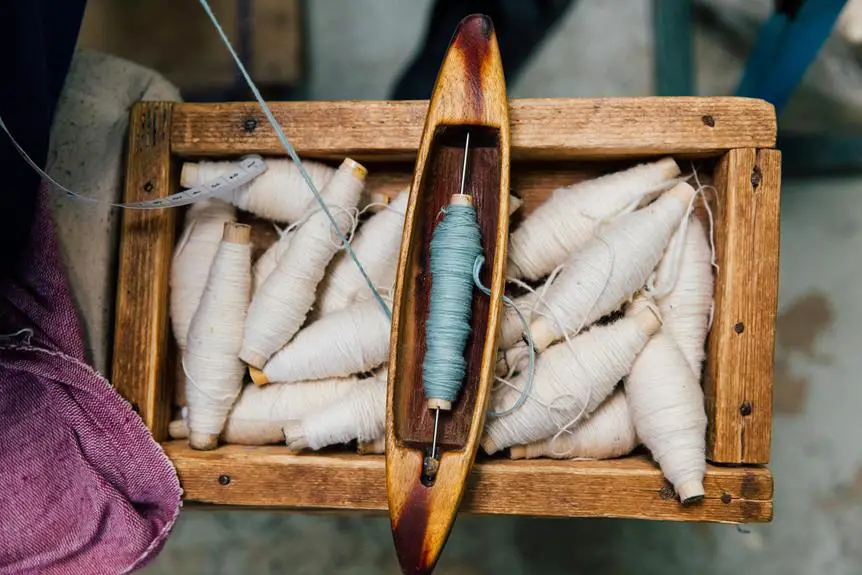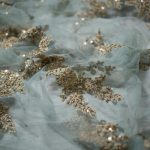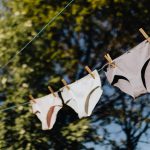When you consider gossamer fabric, you might wonder about its stretchiness. It does have a degree of elasticity, but it's not on par with more stretchy materials like spandex. This quality allows gossamer to drape and flow elegantly, making it a popular choice in fashion. However, the subtle balance between stretch and structure can influence its applications significantly. So, what does this mean for your projects or wardrobe? You'll find the answer might surprise you as you explore the intricacies of this unique fabric.
Table of Contents
Understanding Gossamer Fabric
Gossamer fabric is a lightweight and sheer material often used in garments and crafts, known for its delicate appearance and soft texture. When you touch it, you'll notice how ethereal and fragile it feels, almost as if it's floating in the air.
While it's commonly associated with formal wear, such as evening gowns and bridal attire, its versatility doesn't end there. You can also use gossamer in various DIY projects and home decor, enhancing everything from window treatments to table settings.
One of the exciting features of gossamer is its ability to catch light beautifully, creating an enchanting visual effect. As you explore options for your next project or outfit, consider how this fabric can add elegance and sophistication.
However, be aware that gossamer isn't particularly durable. You'll need to handle it with care, especially during washing and storage. Its delicate nature means it's not the best choice for heavy wear or high-stress situations.
Still, when used appropriately, gossamer fabric can elevate your creations, making them look exquisite and refined. Embrace its unique qualities, and you'll find it's a wonderful addition to your fabric collection.
Composition of Gossamer Materials
When you explore gossamer fabrics, you'll notice the variety of fiber types used in their composition.
Understanding the different types of fibers and the weaving techniques employed can really enhance your appreciation of this delicate material.
Let's break down these key components to see how they contribute to the fabric's overall characteristics.
Fiber Types Explained
Understanding the fiber types that compose gossamer materials is crucial for appreciating their unique qualities and applications.
Gossamer fabrics are typically made from lightweight fibers, which can include silk, nylon, and polyester. Silk is often favored for its luxurious feel and natural sheen, providing an elegant finish that drapes beautifully. Its fine threads create a delicate, airy appearance, making silk gossamer perfect for special occasions.
Nylon is another popular fiber choice, known for its durability and resistance to wear and tear. When you opt for nylon gossamer, you're getting a fabric that can withstand the rigors of daily use, all while maintaining a soft texture.
Polyester, on the other hand, is celebrated for its moisture-wicking properties and color retention, ensuring that your gossamer fabric stays vibrant even after multiple washes.
When you're choosing gossamer materials, it's essential to consider these fiber types. Each has its specific attributes that can enhance the final product's appearance, functionality, and longevity.
Fabric Weaving Techniques
The weaving techniques used in creating gossamer fabrics play a vital role in determining their final look and feel. These techniques blend artistry with precision, resulting in airy, lightweight materials that still maintain a luxurious appearance.
When you explore gossamer fabrics, you'll notice how each method imparts unique characteristics.
- Plain Weave: This foundational technique creates a flat and smooth surface, enhancing gossamer's delicate charm. It's straightforward yet effective, allowing for easy draping and movement.
- Twill Weave: With this technique, diagonal lines add depth and texture, giving gossamer fabrics a slightly more structured look. It's perfect for adding visual interest without compromising the fabric's lightness.
- Jacquard Weave: This intricate method produces stunning patterns, elevating gossamer into a statement piece. The combinations of colors and designs can transform an ordinary fabric into a work of art, making it ideal for special occasions.
Stretch Characteristics of Gossamer
When examining the stretch characteristics of gossamer, you'll want to consider its material composition closely.
Comparing its stretchability to other fabrics will highlight its unique qualities.
Understanding these factors will help you see where gossamer fits in various applications.
Material Composition Analysis
Gossamer fabric, composed primarily of fine silk or synthetic fibers, often exhibits a delicate stretch that enhances its adaptability in various applications. This unique elasticity allows the fabric to drape beautifully, conforming to the shapes it encounters.
To help you visualize the exceptional qualities of gossamer, think about these features:
- Softness: The fine composition gives it a luxurious, buttery feel against your skin, making it ideal for dress linings or delicate garments.
- Lightweight: Similar to a feather, gossamer is incredibly light, making it perfect for layering without adding bulk.
- Sheerness: The transparency of gossamer creates an ethereal effect, allowing a glimpse of color and texture beneath, adding depth to your outfit.
Thanks to its material makeup, gossamer can stretch slightly while still retaining its shape. This quality not only makes it comfortable but also versatile, as it can be used in fashion, costume design, and even home decor.
When you choose gossamer, you're opting for a fabric that combines elegance with functionality, allowing for beautiful designs that flow with movement.
Stretchability Compared to Others
While many fabrics offer varying degrees of stretch, gossamer stands out with its subtle but effective elasticity, making it a unique choice for designs that require both softness and flexibility.
Compared to materials like spandex or Lycra, gossamer may not provide the same level of extreme stretch. However, its lightness and delicate structure create a gentle give that enhances comfort without compromising the fabric's integrity.
When you examine gossamer alongside cotton or silk, you'll find that its stretchability is notably different. Cotton, while durable, tends to be less forgiving and might restrict movement. Silk, on the other hand, is smooth but lacks the same elastic response found in gossamer.
This unique combination allows gossamer to adapt subtly to body movements, making it ideal for layering or draping in garments. Its stretch characteristics enable it to fit snugly without being constricting.
Therefore, if you're considering fabrics that balance delicacy with a touch of elasticity, gossamer presents an attractive option, giving you a refined feel without sacrificing comfort or style.
Typical Uses and Applications
Utilizing gossamer's subtle stretch characteristics, designers often incorporate it into layered garments, evening wear, and intricate accessories. The unique ability of gossamer to stretch slightly while maintaining its ethereal quality makes it a favorite in the fashion industry. You'll find it enhances the appeal of several stunning pieces.
Consider these typical applications:
- Flowy Evening Gowns: The delicate draping of gossamer allows for graceful movement as you glide across the dance floor.
- Chic Scarves: A gossamer scarf adds an elegant touch to your outfit, providing style while remaining lightweight and airy.
- Intricate Bridal Veils: The soft, sheer layers of gossamer lend a romantic feel to bridal wear, creating a dreamy ambiance on your special day.
In addition to these uses, gossamer can also be employed in home decor items and artistic installations, making it a versatile fabric choice.
Its stretchiness contributes not just to aesthetic appeal but also to comfort, ensuring you feel fantastic while looking fabulous.
Common Uses of Gossamer Fabric
Many designers choose gossamer fabric for its delicate, lightweight nature that's perfect for creating ethereal garments and intricate details. You'll often find this fabric used in high-fashion runway collections, where it adds a dreamlike quality to dresses and skirts. Designers love to drape it for flowing silhouettes or layer it for added dimension.
Gossamer's versatility also makes it a favorite for evening wear and bridal gowns. Its sheer finish can create romantic veils, overlays, or delicate trims, enhancing the overall elegance of the attire. You might even see gossamer in formal wear, accentuating sleeves or bodices to provide a whimsical touch.
The fabric's flexibility lends itself well to accessories, too. Think about lightweight scarves, stoles, or wraps that add just the right amount of softness to your outfit. Moreover, some costume designers utilize gossamer for theatrical purposes, crafting costumes that require both visual impact and movement.
In addition, you can find gossamer used in home decor, like curtains or table overlays. Its sheer quality allows for light to filter softly, creating an inviting ambiance in any space. Overall, gossamer fabric opens up a world of creative possibilities.
Care and Maintenance Tips
Caring for gossamer fabric requires gentle handling to preserve its delicate beauty and ensure longevity. Since this fabric is lightweight and often sheer, it's important to treat it with care. Here are some essential tips to help you maintain your gossamer pieces:
- Hand Wash Only: Use cold water and a mild detergent. Swirl the fabric gently in the water, avoiding any aggressive scrubbing. Rinse thoroughly to remove soap without wringing or twisting the fabric.
- Air Dry: Lay the gossamer flat on a clean, dry towel or hang it to dry away from direct sunlight. This helps maintain its shape and texture while preventing fading and damage from heat.
- Store Properly: When not in use, fold your gossamer fabric carefully and store it in a breathable cotton bag or a drawer lined with tissue paper. Avoid hanging it for long periods, as this can cause stretching.
Alternatives to Gossamer Fabric
If you're looking for alternatives to gossamer fabric, consider lightweight options like chiffon or organza that offer similar sheerness and flow. These fabrics can elevate your designs without sacrificing elegance.
Here's a quick comparison to help you choose the right fabric for your project:
| Fabric | Characteristics |
|---|---|
| Chiffon | Soft, airy, and lightly textured. Good for draping and layering. |
| Organza | Crisp and slightly stiffer, perfect for structure in garments or decor. |
| Tulle | Net-like and often used for fullness in skirts or veils. |
| Voile | Lightweight and semi-sheer, with a softer drape than chiffon. |
Each fabric has unique qualities that can enhance your creations. When selecting an alternative, think about the drape, structure, and desired effect. You'll find that options like chiffon and organza are versatile for everything from dresses to home decor, while tulle and voile add distinct textures. So, explore these alternatives and discover which one suits your vision best!
Frequently Asked Questions
Can Gossamer Fabric Be Used for Outdoor Gear?
Yes, you can use gossamer fabric for outdoor gear. Its lightweight nature makes it easy to carry, but you should consider its durability and weather resistance to ensure it holds up in outdoor conditions.
How Does Gossamer Compare to Silk in Stretchiness?
When you compare gossamer to silk, you'll find gossamer is generally less stretchy. While silk has a natural elasticity that allows for some give, gossamer tends to maintain its structure more rigidly during use.
Is Gossamer Fabric Vegan-Friendly?
Yes, gossamer fabric is vegan-friendly. It's typically made from synthetic fibers, which means it doesn't contain any animal products. You can confidently choose gossamer for your vegan wardrobe without worrying about ethical concerns.
What Colors Are Available for Gossamer Fabric?
Gossamer fabric usually comes in a variety of colors, including pastel shades like pink, blue, and lavender, as well as vibrant hues like red, green, and yellow. You'll find plenty of options for your projects!
Can I Dye Gossamer Fabric Easily?
You can dye gossamer fabric, but it's not always easy. It absorbs dye differently, so test a small piece first. Use fabric dyes specifically designed for delicate materials to achieve the best results and color retention.
- How Does Ring Spun Cotton Affect Garment Fit and Shape Retention? - August 13, 2024
- What Are the Challenges in Producing Ring Spun Cotton? - August 13, 2024
- Is Ring Spun Cotton Suitable for Plus-Size Clothing? - August 13, 2024







